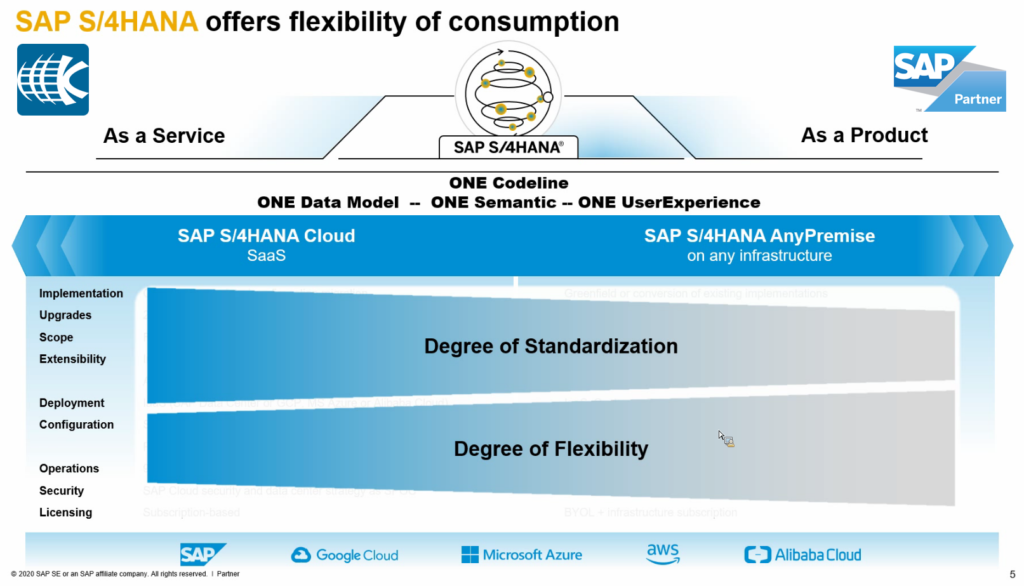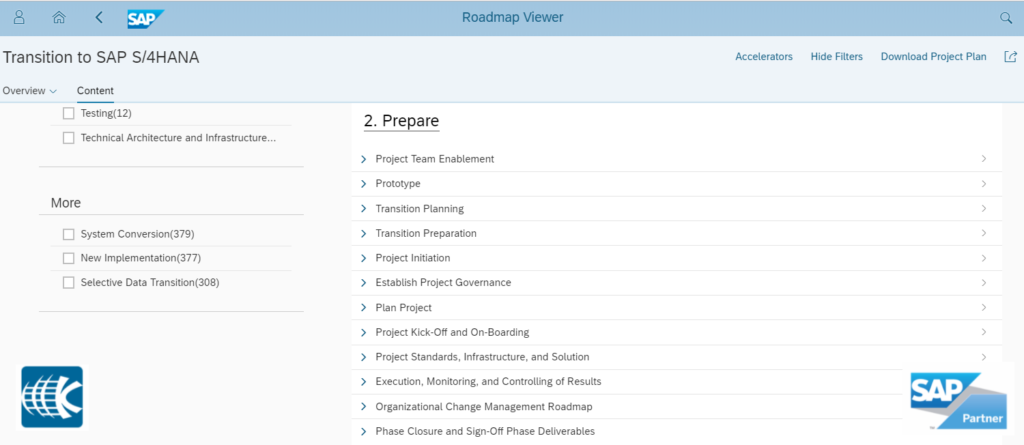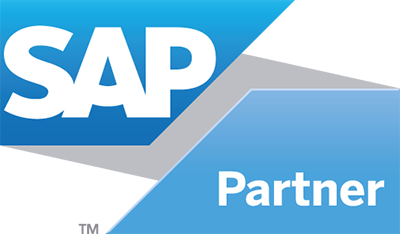SAP End to End Implementation
What is SAP End to End Implementation?
SAP End to End Implementation stands for Systems, Applications & Products Implementation. It is a set of practices and workflows to implement SAP ERP software solution and it is intended to design, build and tune an SAP landscape. We are providing implementation services to the following
- SAP S/4HANA Cloud and On-Premise Deployment Options
- SAP Successfactors HXM Suite
SAP S/4HANA Cloud and On-Premise Deployment Options
SAP solution architects and explains the different deployment options for SAP S/4HANA. It covers cloud, on-premise and hosted deployment options
- SAP S/4HANA Cloud: previously called essentials edition (ES) and Multi-Tenant Edition
- SAP S/4HANA Cloud extended edition: previously called Single-Tenant Edition
- SAP S/4HANA Cloud, private edition (new in 2021)
- SAP S/4HANA On-Premise managed by SAP (HEC)
- SAP S/4HANA On-Premise: On-Premise or managed by cloud provider Hyperscalers
We cover the following aspects of each option: infrastructure, license, how upgrades are managed, scope (functional, country and industry), configuration, extensibility (how solution can be extended beyond configuration) and implementation (possible approaches). All options can be implemented by the customer, SAP or a partner.
We also cover which roadmap of the SAP Activate implementation methodology is relevant, what SAP Best Practices are used and what tools are relevant. See my other blog for an overview of SAP Best Practices and Model Companies.

SAP S/4HANA Cloud
Commonly used by net new customers that want the full cloud approach with regular upgrades that include new configuration and new software. Also used for subsidiaries alongside SAP on-premise implementations.
- Infrastructure: public cloud shared with other customers and hosted and operated by SAP only
- License: subscription for Software as a Service
- Upgrades: managed by SAP. fixed and mandatory (configuration and software). The upgrade of configuration is unique to Essentials Edition. SAP and customer do automated and manual regression tests.
- Scope: core ERP (subset of full ERP) and specific industries and 42 countries
- Extensibility: Key user extensibility and extensions through SAP Cloud Platform (side-by-side extensibility) with whitelisted APIs. See PDF in SAP note 2920697.
- Configuration: use Self Service Configuration User Interfaces (SSCUIs) based on fit-to-standard workshops in the Explore phase
- Implementation: greenfield only (new implementation)
- SAP Activate roadmap: SAP Activate Methodology for SAP S/4HANA Cloud
- SAP Best Practices: scope is selected from these cloud-specific Best Practices. https://rapid.sap.com/bp/#/BP_CLD_ENTPR
- Partner content: partners can add configuration manually.
- You can choose to use the Implementation Portal for SAP S/4HANA Cloud to manage your project. See: https://support.sap.com/en/alm/sap-cloud-alm/implementation-portal.html
Unlike all the other deployment options, the user interface is purely Fiori launchpad and configuration is done using SSCUIs and not the IMG.
SAP S/4HANA Cloud extended edition
Has advantages of the cloud with more flexibility and control. Has standardized infrastructure processes, services and SLAs. There must be more than a certain minimum number of users i.e. this option is for mid and large size customers.
- Infrastructure: dedicated landscape on cloud infrastructure operated by SAP (SAP or Hyperscaler e.g. Microsoft Azure, AWS, Google Cloud)
- License: subscription for software
- Upgrades: two per year with flexibility (software). SAP and customer manage the upgrade process and SAP and customer do regression testing.
- Scope: same S/4HANA functional scope as on-premise. 64 countries, 39, languages and 25 industries. Some third-party add-on limitations.
- Extensibility: In-App extensibility including key user extensibility and some classic ABAP extensibility but no modifications. Also extensions through SAP Cloud Platform (side-by-side extensibility). See PDF in SAP note 2920697.
- Configuration: use the IMG based on fit-to-standard workshops in the Explore phase. Some restrictions apply.
- Implementation: greenfield (new implementation)
- SAP Activate roadmap: SAP Activate Methodology for SAP S/4HANA Cloud EX
- SAP Best Practices: SAP Best Practices are available. Enterprise Management Layer (like the Multi-national corporation Model Company) is included in the subscription and is available for a production system Note: the on-premise Best Practices are used https://rapid.sap.com/bp/BP_OP_ENTPR
- Partner content: partners can add configuration manually.
- Customers use SAP Solution Manager and/or Cloud ALM to manage their project design.
Also see this blog on the 5 golden rules for extended edition (formerly single tenant edition). https://blogs.sap.com/2018/07/28/the-5-golden-rules-for-implementing-sap-s4hana-cloud-single-tenant-edition/
SAP S/4HANA Cloud private edition
Has advantages of the cloud with the ability to move to cloud using a system conversion. Has standardized infrastructure processes, services and SLAs.
- Infrastructure: dedicated landscape on cloud infrastructure operated by SAP and running at a Hyperscaler e.g. Microsoft Azure, AWS, Google Cloud)
- License: subscription for software
- Upgrades: annual and you chose your own speed but must stay in mainstream support. The customer must manage the upgrade process. SAP does specific technical aspects of the upgrade only.
- Scope: same S/4HANA functional scope as on-premise. 64 countries, 39, languages and 25 industries.
- Extensibility: In-App extensibility including key user extensibility and classic ABAP extensibility. Modifications are not recommended but are available. Also extensions through SAP Cloud Platform (side-by-side extensibility).
- Configuration: use the IMG based on fit-to-standard workshops in the Explore phase.
- Implementation: greenfield (new implementation), system conversion or selective data transition
- SAP Activate roadmap: SAP Activate Methodology for SAP S/4HANA Cloud private edition
- SAP Best Practices: SAP Best Practices are available. Enterprise Management Layer (like the Multi-national corporation Model Company) is available for a production system Note: the on-premise Best Practices are used https://rapid.sap.com/bp/BP_OP_ENTPR
- Partner content: partners templates allowed.
- Customers use SAP Solution Manager and/or Cloud ALM to manage their project design.
SAP S/4HANA On-Premise managed by SAP (HEC)
An on-premise solution with individual and private hardware and infrastructure hosted by SAP, a hyperscaler or in your own data center. Infrastructure management delegated to SAP with flexible service offerings.
- Infrastructure: customer specific landscape on SAP HANA Enterprise Cloud (HEC) in SAP data centre or at a hyperscaler or in your own data center (Customer Edition).
- License: Bring Your Own License and infrastructure subscription
- Upgrades: annual and you choose your own speed of adoption (software). Customer is responsible for managing the upgrade.
- Scope: full S/4HANA functional, country and industry scope and partner add-ons
- Extensibility: customization, modification, and extensibility possible as with ERP
- Configuration: use the full IMG based on a fit-to-standard approach in the Explore phase
- Implementation: new implementation, system conversions or selective data transition
- SAP Activate roadmap: Transition to SAP S/4HANA
- SAP Best Practices: all SAP Best Practices and Model Companies are available. https://rapid.sap.com/bp/BP_OP_ENTPR
- Partner content: partner templates allowed.
- Customers use SAP Solution Manager to manage their project design. Most customers use SAP Best Practices activated using SAP Solution Builder or set up by SAP through a Model Company service.
The SAP Activate roadmap has 3 approaches: new implementation, system conversion or selective data transition. The term “selective data transition” is used instead of “landscape transformation” in the latest version of the roadmap. In this approach, there are tools to selectively transfer configuration and custom code from your old ERP system to a new SAP S/4HANA instance. System conversion involves converting your existing ERP system into SAP S/4HANA by migrating the database, applying software updates and doing a data conversion from the old data model to the new S/4HANA data model.
SAP S/4HANA Any Premise: On-Premise or managed by cloud providers Hyperscaler
On-premise SAP S/4HANA managed by the customer in their own data centre or managed by a third party.
- Infrastructure: customer data centre or hosted by hyperscaler (e.g. e.g. Microsoft Azure, AWS, Google Cloud)
- License: perpetual or Bring Your own License
- Upgrades: annual and you choose your own speed of adoption (software). Customer is responsible for managing the upgrade.
- Scope: full S/4HANA functional, country and industry scope and partner add-ons
- Extensibility: customization, modification, and extensibility possible as with ERP
- Configuration: use the full IMG based on a fit-to-standard approach in the Explore phase
- Implementation: new implementation, system conversions or selective data transition
- SAP Activate roadmap: Transition to SAP S/4HANA
- SAP Best Practices: all SAP Best Practices and Model Companies are available for sandbox systems. https://rapid.sap.com/bp/BP_OP_ENTPR
- Partner content: partner templates allowed.
- Customers may use SAP Solution Manager to manage their project design. Many customers use SAP Best Practices activated using SAP Solution Builder or set up by SAP through a Model Company service.
- The route selected by 50% of customers is a “system conversion” where your existing system is converted to S/4HANA. This means option 3, 4 or 5.
- If you want to start again on a new page and do a “new implementation”, you can choose any deployment option. Note: option 1 may not cover all the processes and scope in your current solution.
- The “selective data transition” approach allows you to take some of your existing solution into a new S/4HANA instance. Option 3, 4 or 5 can be used. 5% of customers choose this approach.
See me related blog on moving to S/4HANA from ERP: https://blogs.sap.com/2019/10/30/how-to-move-to-sap-s4hana/. This blog may also be helpful:https://blogs.sap.com/2020/05/11/sap-s-4hana-deployment-on-hyperscalers/
When using the Transition to SAP S/4HANA SAP Activate roadmap, be sure to select the approach on the content screen. See below.

SAP SuccessFactors HXM Suite
Traditional human capital management (HCM) systems were not built with employees’ needs and wants in mind. By transforming HCM into HXM (Human Experience Management) you can help your customers transform the way they engage with their people and deliver the experiences their employees have always wanted.
Resources
At its core, the SAP SuccessFactors HXM Suite is a global, cloud-based human resource management software system. The suite solutions add value for your customers to create a wholistic cloud Human Resource management system that fits their organization’s needs. Utilize the below container pages by solution during your sales and implementation discussions with customers. These pages contain all relevant sell and implement content for partners.
- Core HR and Payroll
- Talent Management
- HR Analytics and Workforce Planning
Core HR and Payroll
Support employees wherever and however they need to work with global solutions for core HR, payroll, time tracking, and more.
- SAP SuccessFactors Employee Central
- SAP SuccessFactors Employee Central Payroll
- SAP SuccessFactors Visa and Permit Management
- SAP SuccessFactors Time Tracking
- SAP WorkZone for HR
Talent Management
Adapt quickly to fluctuating talent needs with powerful software for recruiting, onboarding, performance, compensation, and more.
- SAP SuccessFactors Compensation
- SAP SuccessFactors Learning
- SAP SuccessFactors Onboarding
- SAP SuccessFactors Performance & Goals
- SAP SuccessFactors Recruiting
- SAP SuccessFactors Succession & Development
HR Analytics and Workforce Planning
Make smarter decisions faster, using data-driven insights in every HR process.
- SAP SuccessFactors People Analytics


